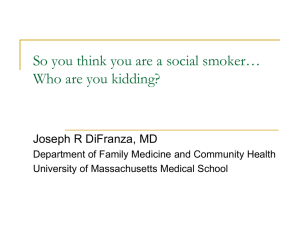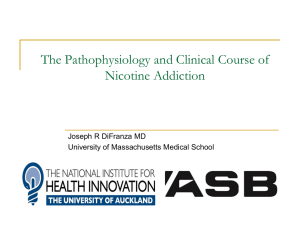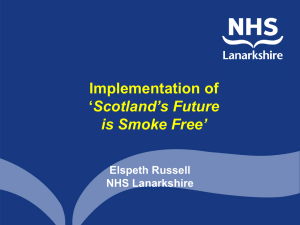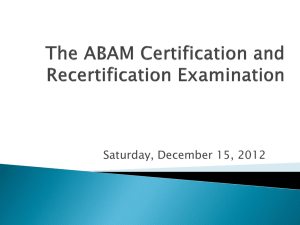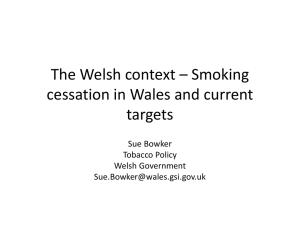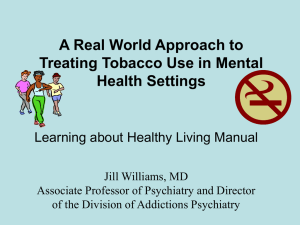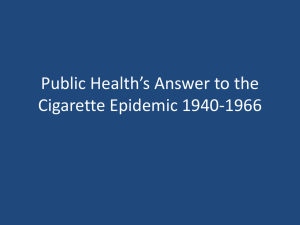How does Nicotine Addiction Start?
advertisement
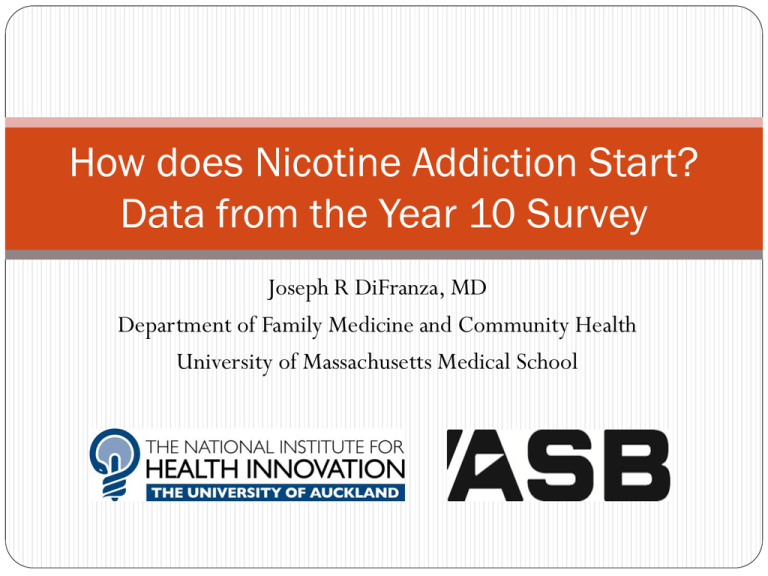
How does Nicotine Addiction Start? Data from the Year 10 Survey Joseph R DiFranza, MD Department of Family Medicine and Community Health University of Massachusetts Medical School The Hound of the Baskervilles Arthur Conan Doyle-1902 “The more outré and grotesque an incident is the more carefully it deserves to be examined, and the very point which appears to complicate a case is, when duly considered and scientifically handled, the one which is most likely to elucidate it.” –Sherlock Holmes The girl who didn’t read the text book The Development and Assessment of Nicotine Dependence in Youth (DANDY-1) 681 7th year students were followed over 3 years Addiction as a Loss of Autonomy From addictus, meaning assigned A Roman magistrate would assign the loser to perform work or pay a forfeit to the victor. Addiction does not mean self-destruction, it means you have an obligation to do something. Loss of Autonomy-when quitting requires an effort or involves discomfort Hooked on Nicotine Checklist 1) Have you ever tried to quit, but couldn’t? 2) Do you smoke now because it is really hard to quit? 3) Have you ever felt like you were addicted to tobacco? Hooked on Nicotine Checklist 4) Do you ever have strong cravings to smoke? 5) Have you ever felt like you really needed a cigarette? 6) Is it hard to keep from smoking in places where you are not supposed to? Hooked on Nicotine Checklist When you haven't smoked for a while do you… 7) find it hard to concentrate? 8) feel more irritable? 9) feel a strong need or urge to smoke? 10) feel nervous, restless or anxious? The Development and Assessment of Nicotine Dependence in Youth (DANDY-1) Each of the 10 HONC symptoms had appeared within a few weeks of initiating smoking. Median usage at symptom appearance was 2 cigarettes/week. Girls developed symptoms after a mean of 21 days and boys after 183 days. The Development and Assessment of Nicotine Dependence in Youth (DANDY-1) The appearance of one or more HONC symptoms predicted A failed quit attempt (OR = 29) Continued smoking (OR = 44) Progression to daily smoking (OR = 58) Trajectory of Use Before HONC Symptoms Start: 2% Intermittent End: 4% 0.07 Start: 60% Start: 30% 0.25 Sporadic 0.07 End: 14% Occasional 0.42 0.05 Daily 0.02 End: 5% 0.53 Start: 9% 0.05 End: 4% 0.11 0.21 0.14 0.04 Start: 0% Abstinent End: 72% Start: 0% 0.02 Escalating End: 2% Trajectory of Use After HONC Symptoms Start: 0% Intermittent End: 10% 0.16 0.15 0.10 Start: 40% Sporadic End: 6% Start: 46% 0.27 0.05 Start: 14% 0.46 Occasional Daily 0.18 End: 15% 0.44 0.15 0.03 0.14 0.20 Abstinent End: 21% End: 26% 0.06 0.36 Start: 0% Escalating End: 22% 0.23 0.13 Start: 0% 0.29 Nicotine Dependence in Teens Study Quebec Ongoing 13-year longitudinal cohort n=1293 grade 7 students (age 12-13) in 10 high schools Figure 2. Cumulative probability of attaining cigarette smoking onset milestones according to time (months) since initiation (n=311) 1 0.9 0.8 Inhale into lungs Whole cigarette Probability 0.7 Mental addiction Cravings 0.6 Physical addiction Smoke monthly 0.5 Withdrawal symptoms Tolerance 0.4 Smoke weekly 100 cigarettes 0.3 Smoke daily ICD-10 dependent 0.2 0.1 0 0 6 12 18 24 30 36 42 48 54 Number of subjects at risk according to number of months after initiation Inhale into lungs 311 112 62 44 32 22 13 10 5 1 Whole cigarette 311 161 113 83 62 42 23 14 5 0 Mental addiction 311 * 180 135 98 76 56 40 21 11 2 Cravings 311 201 162 121 98 77 51 30 17 3 Physical addiction 311 * 204 166 130 102 81 59 35 17 2 Smoke monthly 311 233 178 148 114 91 59 40 21 4 Withdrawal symptoms 311 221 187 150 121 98 70 37 15 2 Tolerance 311 236 198 157 127 97 68 38 19 4 Smoke weekly 311 246 210 170 141 115 84 49 24 4 100 cigarettes 311 250 213 169 135 107 79 50 22 2 Smoke daily 311 251 223 182 145 116 92 55 28 2 ICD-10 dependent 311 259 229 189 160 128 97 58 29 3 * 36 subjects reported mental addiction, and 15 subjects reported physical addiction prior to initiation. These subjects were considered to be incident cases at time 0. They contributed 0 person-months to the denominator in the computation of time at risk for developing selected milstone. Months Figure 2. Cumulative probability of attaining cigarette smoking onset milestones according to time (months) since initiation (n=311) 1 0.9 0.8 Inhale into lungs Whole cigarette Probability 0.7 Mental addiction Cravings 0.6 Physical addiction Smoke monthly 0.5 Withdrawal symptoms Tolerance 0.4 Smoke weekly 100 cigarettes 0.3 Smoke daily ICD-10 dependent 0.2 0.1 0 0 6 12 18 24 30 36 42 48 54 Number of subjects at risk according to number of months after initiation Inhale into lungs 311 112 62 44 32 22 13 10 5 1 Whole cigarette 311 161 113 83 62 42 23 14 5 0 Mental addiction 311 * 180 135 98 76 56 40 21 11 2 Cravings 311 201 162 121 98 77 51 30 17 3 Physical addiction 311 * 204 166 130 102 81 59 35 17 2 Smoke monthly 311 233 178 148 114 91 59 40 21 4 Withdrawal symptoms 311 221 187 150 121 98 70 37 15 2 Tolerance 311 236 198 157 127 97 68 38 19 4 Smoke weekly 311 246 210 170 141 115 84 49 24 4 100 cigarettes 311 250 213 169 135 107 79 50 22 2 Smoke daily 311 251 223 182 145 116 92 55 28 2 ICD-10 dependent 311 259 229 189 160 128 97 58 29 3 * 36 subjects reported mental addiction, and 15 subjects reported physical addiction prior to initiation. These subjects were considered to be incident cases at time 0. They contributed 0 person-months to the denominator in the computation of time at risk for developing selected milstone. Months Months to Cigarette Use Milestones 0 12 24 Smokes daily 23 Smokes monthly 9 Whole cigarette 3 Inhalation 2 Smokes weekly Lifetime 100 cigs 19 36 48 Months Onset of ND Symptoms 0 12 Cravings 5 Tolerance 14 Withdrawal 12 Smokes monthly 9 Whole cigarette 3 Inhalation 2 24 Smokes daily 23 Smokes weekly Lifetime 100 cigs 19 36 48 Months ICD-10 Tobacco dependence 46 DANDY 2 study N=217 inhalers followed up to 4 years 10% had lost autonomy within 2 days 25% had lost autonomy within 30 days 25% had lost autonomy by the time they were smoking 1 cigarette/month Students were smoking an average of 2 cigarettes/week when addiction started. ICD-10 dependence as early as 13 days DANDY 2 study Among subjects who had ever puffed on a cigarette a HONC symptom increased the risk of progressing to daily smoking: OR=196. Among subjects who had inhaled a HONC symptom increased the risk of daily smoking: OR= 83. New Zealand 10th Year Survey Three consecutive annual surveys 2002-2004 24,995 current smokers Percent with Diminished Autonomy 100 90 80 70 60 Girls 50 Boys 40 30 20 10 0 1 2 3-4 5-9 10 - 19 Lifetime Cigarette Consumption 20 - 99 >100 Loss of Autonomy in Relation to Smoking Frequency 100 90 80 70 60 Boys 50 Girls 40 30 20 10 0 Less than monthly Monthly Weekly Daily Loss of Autonomy 100 90 80 Percent 70 60 50 40 30 20 10 0 Less than monthly Monthly Weekly Frequency of Smoking Daily 100 90 80 70 Percent 60 50 40 30 20 10 0 1 2 3-4 5-9 10 -19 20 - 99 Lifetime Cigarette Consumption – actual data Proportion with Lost Autonomy Proportion Abstinent >100 10th Year Survey Symptoms appear after one cigarette The process proceeds faster in girls It is well underway prior to daily use Chicago Study 35% of youth who had experienced a symptom of dependence had done so within one month of initiation. The First Case Series on Nicotine Addiction Abstinence provokes a desire to smoke in all addicted smokers. How would you describe this need to someone who has never smoked? Wanting Craving Needing Wanting Wanting is a mild transient desire to smoke that is easily ignored. “It’s like wanting some chocolate.” Craving Craving is more intense than wanting and intrudes upon the person’s thoughts. It is more persistent and is difficult to ignore. “I feel like someone inside of me is really telling me to smoke.” Craving “just, like, pops in your head, like someone is sending you a message.” Craving Craving is like “being hungry, but instead of your stomach saying it, it’s your brain…it’s just hungry, except for a cigarette.” “I’ve felt, like, physical urges, like just craving them, but not like a mental thing.” Needing Needing is an intense and urgent desire to smoke that is impossible to ignore. The individual must smoke to restore a normal mental or physical state. “Pretty urgent… you need it and you can’t get your mind off it.” “You really want one.You know you need it. You know you’ll feel normal after smoking, and you have to smoke to feel normal again.” When addiction first develops No withdrawal symptoms Wanting Wanting and Craving Wanting, Craving, and Needing Clinical Staging of Nicotine Addiction Stage 1 No withdrawal symptoms Smokers can remain abstinent indefinitely without withdrawal symptoms. Stage 2 Wanting “If I go too long without smoking the first thing I will notice is a mild desire to smoke that I can ignore.” Stage 3 Craving “If I go too long without smoking, the desire for a cigarette becomes so strong that it is hard to ignore and it interrupts my thinking.” Stage 4 Needing “If I go too long without smoking, I just can’t function right, and I know I will have to smoke just to feel normal again.” Mean Adolescent HONC Scores by Stage 10 9 8 Score 7 6 5 4 3 2 1 0 Stage 1 Stage 2 Stage 3 Stage 4 Mean Adult HONC Scores by Stage 10 9 8 Score 7 6 5 4 3 2 1 0 Stage 1 Stage 2 Stage 3 Stage 4 Days Smoked per Month by Stage (adults) Days smoked per month 30 25 20 15 10 5 0 Stage 1 Stage 2 Stage 3 Stage 4 Number of Cigarettes Smoked on Smoking Days (adults) cigarettes smoked per day 14 12 10 8 6 4 2 0 Stage 1 Stage 2 Stage 3 Stage 4 The Latency to Withdrawal “A little light bulb goes off and it’s like, alright, time [to smoke].” The latency is the interval between smoking one cigarette and wanting, craving, or needing another. Latency-to-wanting Latency-to-craving Latency-to-needing The Latency to Withdrawal At the onset of addiction the latency-to-withdrawal may be longer than a week. Repeated tobacco use causes the latencies to shrink. The shortening of the latency drives the escalation in smoking. The Latency to Withdrawal After smoking for 6 weeks, a 16-year-old girl noticed a Latency to Withdrawal of 2 days which shortened to 4 hours by age 16½ …to 2 hours by age 17, …to 1.5 hours by age 18, …to 1 hour by age 19, …and to 30 to 45 minutes by age 21. The Latency to Withdrawal - Factors of 2 1) 1 week (1 cig/wk) 2) 3.5 days (2 cig/wk) 3) 42 hours 4) 21 hours 5) 11.5 hours 6) 5.6 hours 7) 2.8 hours 8) 1.4 hours 9) 42 minutes (1 ppd) 10) 21 minutes (2 ppd) In adolescents smoking 2 cigs/wk increases the risk for heavy adult smoking 174 fold Summary A Loss of Autonomy marks the onset of addiction. The addiction process begins with the first cigarette and progresses rapidly. Addiction develops through the same sequence of Wanting, Craving, Needing in all smokers. The addiction process is well underway in intermittent smokers. The shortening of the Latency to Withdrawal drives the escalation of smoking and explains why early symptoms are powerful indicators of prognosis.
